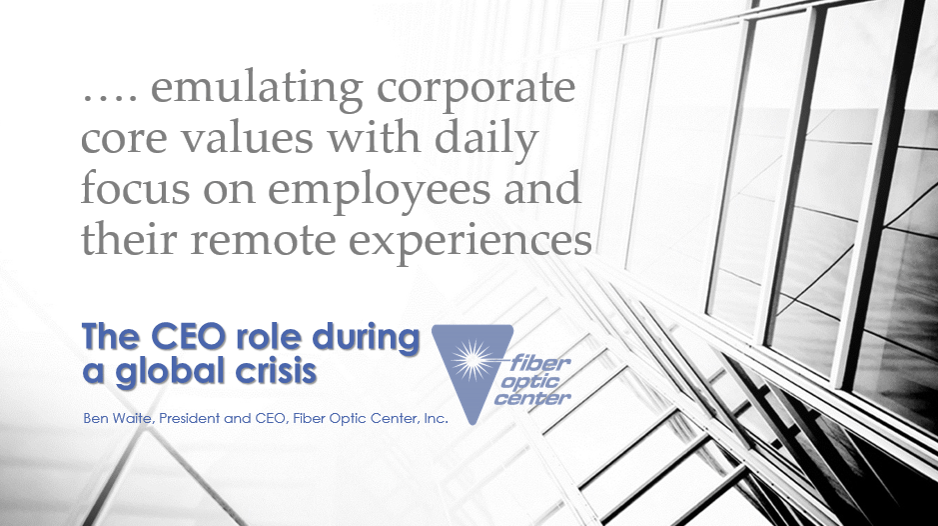Part II: the CEO role during a global crisis
CEO responsibilities, for the overall success of an organization, include creating frameworks for work delegation, establishing talented management and systems, and the strategy and goals for operations, marketing, financing, sales, customer service, the company’s culture and corporate core values.
As CEO and President, I try to emulate our company core values with daily focus on our employees and their remote location experiences. During this pandemic, it is my responsibility to ensure our people remain safe, strong, and engaged. In addition to evaluating and maintaining awareness of the current crisis and developing new corporate systems and procedures, as noted in Part I, I have a checklist of four C’s to provide to my employees: Clarity, Communication, Connection and Consideration.

Clarity includes both setting clear expectations and guidelines for all employees as well as agreed individual plans.
- Expectations: are specific to each person’s position, tasks and goals. These discussions also include accountability and how to measure expectations and performance. Of course, it is easier to evaluate levels of effort when everyone is physically present in headquarters, but we have worked on defining new measures. For example, redefining “close of business” (COB) or “end of day” (EOD) is important, as many conscientious workers will not be closing or ending their day until much later if they had ‘at-home’ interruptions during the normal work hours.
Setting expectations for team members, is not only focused on the less productive or self-motivated employees. Most organizations have overachieving workers who also need protection from burn out. Clear boundaries help employees from getting trapped in endless workdays that can ultimately lower production through exhaustion. - Guidelines: include expanded technology support and how to access it, with availability for hours each person is working and procedures for handling issues outside of regular hours in our headquarters.
- Individual plans: provide flexibility to accommodate homeschooling, young children and other family circumstances.
FOC is a global company and has employees outside headquarters, in different countries and time zones. So we have well-established systems for remote working with many employees. With the covid-19 changes, we’ve developed new systems to address the travel bans plus some cases where our employees have more family members in the home-office workspace. Some of our headquarters’ staff has to set up new home offices and in some cases contend with broadband-connection issues in their communities.
Communication has become critical during this remote work era, requiring a balance of contact with individuals and groups. In addition, we’ve had to look at ways to build rapport among remote workers. The challenges include:
- Content: Updates with well-organized information on the industry, government mandates, and corporate planning help employees focus on their position, knowing that their leader is focused on those details. Communication from a CEO can imply micromanaging. There are ongoing needs for conversations about what someone is working on or needs help with, but work-from home brings a new requirement to better know the person and what his or her life challenges are in addition to job challenges.
- Frequency: I give company-wide updates regularly, with a balance of respecting our team’s time and not updating for the sake of doing so. I also know that strong leadership keeps everyone engaged and connected while remote, so I do check ins frequently and try to replace the informal office conversations that relationships can be made of. My goal is to listen, respond, trust, and communicate with respect.
- Interpretation: Phone and especially email communication lack facial expression, tone of voice, “body language,” and other non-verbal cues. Thus remote communication increases the chance for miscommunication and conflict. This emphasizes the need for video and other multi-media communication. As noted above, everyone needs clear expectations and reinforced priorities.
Though employees should not dictate the tools, it is best practice to ask how they prefer to be contacted and why. Are text messages a preferred method for urgent issues or so they feel intrusive? Can they videoconference comfortably or do they prefer phone calls? - Engagement: More than ever, while we cannot be together physically, we need to stay engaged. Listening is a skill we all think we have, and most would rate themselves highly, but all of use must work to improve that skill daily. For engagement, all team members must truly listen, not just hear. It starts that the top, and I am working on listening remotely in a different way.
Connection refers to the problem that employees who have recently shifted to a home office can wind up feeling disconnected or lonely, and that can contribute to lower productivity and engagement. One of our corporate core values is honesty and a way for me to strengthen connections on our team is to be honest about my own experiences. I have tried to be real and human and share my own challenges and concerns. Our teams need champions of their concerns. We want to cement the credibility and trust our company is built on.
Consideration means that we must promote creativity while balancing new health risks. This includes new documentation procedures, embracing video conferencing (with occasion background interruptions), letting go of the old normal, and considering the best ways to connect teams and get work done. Trust your teams. Consider personal needs and challenges. Be open to learning and reinventing.
A few of the practices we have been focusing on at FOC have included task-focused and personal interaction balanced work plans. By scheduling check-ins with everyone on the team regularly, we are keeping a dialog and countering the potential to have individuals feeling isolated. Though we utilized internal video conferencing for quite some time, dedicating a few minutes at the beginning of meetings to open-ended questions, such as “What are your weekend plans?” and other topics that normally would have come up in the office are as important as the tasks at hand.
Lastly, using social media and other technology to restore an element of personal conversations has been a fun and healthy connection for both employees and our customers. FOC created the Work-at-Home (WAH) series that consists of funny stories and photos on social media about our individual remote work environments. We are creating new memories with each other about our individual experiences and look forward to the time when we are back in one building or company event to reminisce about them. For now, we will check our ‘feeds’ and comment with humor, other memories and support.



